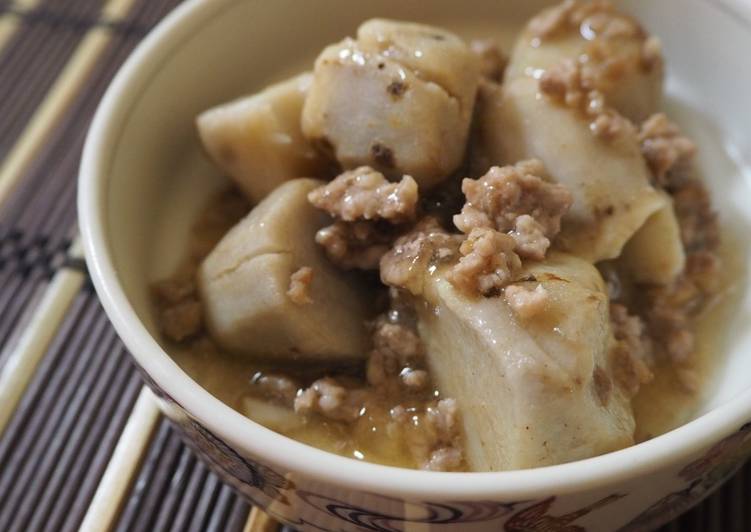Taro Potatoes with Starchy Soy Sauce (Satoimo Ankake). Peel the taro and cut into bite-size chunks. See recipes for Taro Potatoes with Starchy Soy Sauce (Satoimo Ankake) too. 'Taro' potato, 'Satoimo' in Japanese, has creamy & slimy texture and I love it. I often use Frozen Satoimo that are already peeled and ready to cook, because my hands often feel itchy when I peel Satoimo skin.
 Compared to other varieties of taro, Satoimo is smaller in size with a round body.
Satoimo is often simmered in soy sauce, sugar and ginger (creating a sweet and salty flavor) and then added to soups and stocks.
In Japanese cuisine, Satoimo is traditionally boiled in flavored dashi, or simmered for kenchin jiru, a type of hearty miso soup served with tofu and hon shimeji mushrooms.
Compared to other varieties of taro, Satoimo is smaller in size with a round body.
Satoimo is often simmered in soy sauce, sugar and ginger (creating a sweet and salty flavor) and then added to soups and stocks.
In Japanese cuisine, Satoimo is traditionally boiled in flavored dashi, or simmered for kenchin jiru, a type of hearty miso soup served with tofu and hon shimeji mushrooms.
Hey everyone, it is John, welcome to my recipe page. Today, I will show you a way to prepare a distinctive dish, taro potatoes with starchy soy sauce (satoimo ankake). One of my favorites food recipes. This time, I will make it a bit unique. This will be really delicious.
Taro Potatoes with Starchy Soy Sauce (Satoimo Ankake) is one of the most favored of current trending meals in the world. It is easy, it is fast, it tastes yummy. It's enjoyed by millions daily. Taro Potatoes with Starchy Soy Sauce (Satoimo Ankake) is something which I've loved my whole life. They're fine and they look fantastic.
Peel the taro and cut into bite-size chunks. See recipes for Taro Potatoes with Starchy Soy Sauce (Satoimo Ankake) too. 'Taro' potato, 'Satoimo' in Japanese, has creamy & slimy texture and I love it. I often use Frozen Satoimo that are already peeled and ready to cook, because my hands often feel itchy when I peel Satoimo skin.
To get started with this particular recipe, we have to first prepare a few ingredients. You can have taro potatoes with starchy soy sauce (satoimo ankake) using 8 ingredients and 7 steps. Here is how you can achieve it.
The ingredients needed to make Taro Potatoes with Starchy Soy Sauce (Satoimo Ankake):
- {Take 400 g of taro potatoes.
- {Take 150 g of ground meat (chicken or pork).
- {Get 2 tbsp of soy sauce : (A).
- {Prepare 3 tbsp of sake : (A).
- {Prepare 2 tsp of sugar : (A).
- {Prepare 400 mL of dashi broth.
- {Take of oil for panfrying.
- {Make ready 1 tbsp of starch dissolving in 1 tbsp water.
Please LIKE and SUBSCRIBE if you like this video. Other videos will be uploaded every day! Great recipe for Satoimo Taro Tumbles. Glazed Soy Sauce Brown Sugar Chicken Thighs Recipe
Steps to make Taro Potatoes with Starchy Soy Sauce (Satoimo Ankake):
- Peel the taro and cut into bite-size chunks..
- Panfry the minced meat in a greased pan until the texture of the meat become separated..
- Add the taro pieces and keep panfrying..
- Add the condiments (A) and the Dashi broth. Cook over high heat until it comes to a boil. Simmer over medium-low heat until the ingredients are cooked..
- Turn the heat off and add the starch dissolved in water to mix it..
- Heat the pan again and cook until the sauce becomes thick..
- Now your food is ready!.
Taiwanese Taro Balls Recipe I love TARO balls! Fell deeply in love with taro and sweet potato balls during my first trip to�份, Taiwan. Similar taro varieties include giant taro (Alocasia macrorrhizos), swamp taro (Cyrtosperma Colocasia esculenta is a perennial, tropical plant primarily grown as a root vegetable for its edible, starchy corm. The tuber, satoimo, is often prepared through simmering in fish stock (dashi) and soy sauce. Satoimo (里芋) or taro roots are a starchy root crop that is widely enjoyed in Japanese cuisine.
So that's going to wrap this up for this special food taro potatoes with starchy soy sauce (satoimo ankake) recipe. Thanks so much for your time. I'm confident you can make this at home. There's gonna be more interesting food in home recipes coming up. Don't forget to bookmark this page in your browser, and share it to your family, friends and colleague. Thank you for reading. Go on get cooking!
